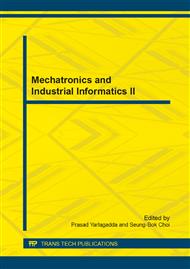[1]
J. Wallace, M. Jensen, A. Swindlehurst, and B. Jeffs, Experimental characterization of the MIMO wireless channel: Data acquisition and analysis, IEEE Trans. Wireless Commun., vol. 2, no. 2, p.335–343, Mar. (2003).
DOI: 10.1109/twc.2003.808975
Google Scholar
[2]
C. A. Balanis, Antenna Theory Analysis and Design. Hoboken, NJ: Wiley, (2005).
Google Scholar
[3]
B. Bhattacharyya, Input resistances of horizontal electric and vertical magnetic dipoles over a homogeneous ground, IEEE Trans. AntennasPropag., vol. 11, no. 3, p.261–266, May (1963).
DOI: 10.1109/tap.1963.1138039
Google Scholar
[4]
F. -G. Zhu, J. -D. Xu, and Q. Xu, Reduction of mutual coupling between closely-packed antenna elements using defected ground structure, Electron Lett 45 (2009), 601–602.
DOI: 10.1049/el.2009.0985
Google Scholar
[5]
S. Farsi, H. Aliakbarian, B. Nauwelaers, and G.A.E. Vandenbosch, Mutual coupling reduction between planar antenna by using a simple microstrip U-section, IEEE Antennas Wireless Propag Lett 11 (2012), 1501–1503.
DOI: 10.1109/lawp.2012.2232274
Google Scholar
[6]
D. Guha, S. Biswas, T. Joseph, M.T. Sebastian, Defected ground structure to reduce mutual coupling between cylindrical dielectric resonator antennas, Electron Lett 44 (2008), 836–837.
DOI: 10.1049/el:20081189
Google Scholar
[7]
F. Yang and Y. Rahmat-Samii, Microstrip antennas integrated with electromagnetic band-gap (EBG) structures: A low mutual coupling design for array applications, IEEE Trans. Antennas Propag., vol. 51, no. 10, p.2936–2946, Oct. (2003).
DOI: 10.1109/tap.2003.817983
Google Scholar
[8]
M. Coulombe, K. S. Farzaneh, and C. Caloz, Compact elongated mushroom (EM)-EBG structure for enhancement of patch antenna array performances, IEEE Trans. Antennas Propag., vol. 58, no. 4, p.1076–1086, Apr. (2010).
DOI: 10.1109/tap.2010.2041152
Google Scholar
[9]
S. D. Assimonis, T. V. Yioultsis, and C. S. Antonopoulos, Computational investigation and design of planar EBG structures for coupling reduction in antenna applications, IEEE Trans. Magn., vol. 48, no. 2, p.771–774, Feb. (2012).
DOI: 10.1109/tmag.2011.2172680
Google Scholar
[10]
M. M. Bait-Suwailam, M. S. Boybay, and O. M. Ramahi, Electromagnetic Coupling Reduction in High-Profile Monopole Antennas Using Single-Negative Magnetic Metamaterials for MIMO Applications, IEEE Trans. Antennas Propag., vol. 58, no. 9, p.2894–2902, Sep., (2010).
DOI: 10.1109/tap.2010.2052560
Google Scholar
[11]
H. -X. Xu, G. -M. Wang, M. -Q. Qi, and H. -Y. Zeng, Ultra-small single-negative electric metamaterials for electromagnetic coupling reduction of microstrip antenna array, Opt. Exp., vol. 20, no. 20, p.21968–21976, (2012).
DOI: 10.1364/oe.20.021968
Google Scholar
[12]
R. Marqués, F. Martín, and M. Sorolla, Metamaterials With Negative Parameters: Theory, Design and Microwave Applications. Hoboken, NJ: Wiley, (2008).
DOI: 10.1002/9780470191736
Google Scholar
[13]
X. Chen, T. M. Grzegorczyk, B. -I. Wu, J. Pacheco, Jr., and J. A. Kong, Robust method to retrieve the constitutive effective parameters of metamaterials, Phys. Rev. E Stat. Nonlin. Soft Matter Phys. 70(1), 016608 (2004).
DOI: 10.1103/physreve.70.016608
Google Scholar


